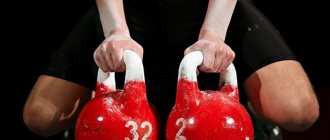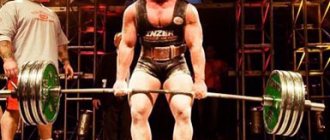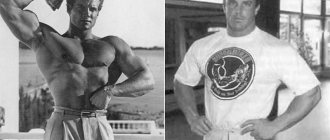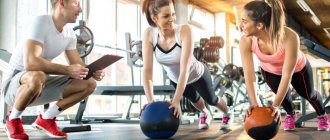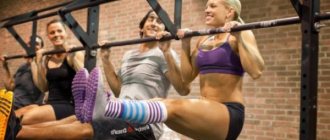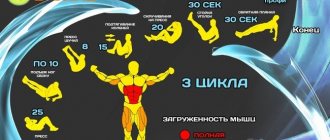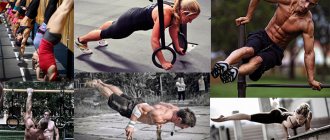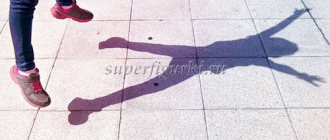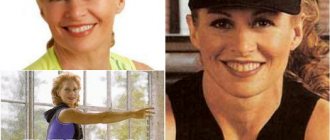Weightlifting training program (2 votes, average: 5,00 out of 5)
Beginning weightlifters must understand that they have a difficult path to go through, which will help them competently prepare their own body for the upcoming loads of big sport; weightlifting and training for every day is not suitable for everyone.
Weightlifting Training Program for Beginners
In addition, it is very important to master the correct exercise technique, otherwise you can get serious injuries and sprains.
Start date
Weightlifting training for beginners, of course, is radically different from the programs used by experienced professionals. But they were just getting started. There has been a lot of controversy about what the sequence of the methodological path should be. So far, no scientific research has been carried out on the issue, the results of which gave a substantiated answer to this question.
Classic exercises must be done in three groups: a jerk with two hands, lifting the barbell to the chest and pushing up from it. When mastering them, you need to remember the characteristics of the sport. The goal of weightlifting is to lift maximum weights. Therefore, the technique of competitive exercises must be studied in combination with a load (apparatus).
If a person does not comply with these fundamental requirements, then there will be consequences. In essence, he will master an erroneous, amateurish technique. If there is no significant additional weight, then the load during acceleration/braking of the bar will not reach the required value.
Already at this stage, a comprehensive approach can be seen, which requires the athlete to perform a number of additional exercises aimed at muscle development. For their successful growth, by the way, you need to follow proper nutrition, which implies a high protein content.
Basic dietary requirements[edit | edit code]
Increased calorie content - especially during the period of weight gain. The average daily calorie intake for weightlifters should be 3500–4500 kcal for men (70 kg) and 3000–4000 kcal for women (60 kg). During the period of intense training and weight gain, the calorie content in strength sports for men is 4200–5100 kcal with the following ratio of main nutrients: proteins – 18–20%, fats – 31–32%, carbohydrates – 49–50%.
In any case, you should approach the issue of calorie intake strictly individually. Calculations must be made especially carefully for bodybuilders - to the point that the athlete must weigh every bite he eats and sit for a long time with a calculator and calorie tables. On the other hand, during the period of mass gain, athletes eat everything, caring only about protein. Naturally, this approach gives very dubious results: first, the muscles become overgrown with a huge amount of fat, and then this fat is lost for a long time and painfully.
Mastering the Snatch
This is where weightlifting begins. Training aimed at familiarizing the athlete with the technique takes place with a barbell pole without weights. It all starts with pulling exercises and the starting stance. That is, a person lifts the barbell to the chest, while straightening the body and legs. Exercises are performed not only from the floor, but also from a certain height (the pole is taken from a box, stand, etc.).
You cannot do without these exercises, since only with their help a beginner can learn to straighten the body correctly. Only after mastering this technique can you begin lunge jerks. In no case with a squat! To get to this point, you must first master the basics and gain experience.
When learning to snatch, novice athletes perform general movement exercises without a apparatus. After that, they learn to clean the barbell. First without lunging. You can get to it only through mastering the squat. It is important to remember that traction plays an important role here, so you should not neglect performing exercises from different positions. By the way, the chest push is also performed without lunges at first.
To connect it with the push, you need to place the barbell on the racks, aligning them at chest level. This is the starting position. From there the athlete performs a push and a lunge. Once these movements are mastered at a decent level, you can combine them.
Working on biceps
Weightlifting cannot do without it. Workouts, as beginners believe, should include bending (exercises with dumbbells, for example) to make the arms larger. But in fact this statement is somewhat erroneous. It is necessary to do the notorious exercises, as well as everything that can help with them: deadlifts and overhead presses, squats on the front and back, pushes. The bottom line is that this is what affects the size of your arms. Power snatches, pull-ups with a snatch and push grip, squat cleans - this can significantly strengthen your arms. To be more precise, the brachialis and brachioradialis muscles.
Many trainers do not recommend doing bending at all, because they waste energy, and it can be spent on more useful exercises that contribute to the development of larger muscle groups that affect the efficiency of lifting weights. Moreover, the vast majority of flexions have a negative impact on arm flexibility. And it is necessary to lift the barbell.
Professional athletes, when describing weightlifting training for beginners, place special emphasis on the fact that large arms, which beginners often chase after, often lead to problems with holding the barbell in the front position. And no matter how much strength an athlete has, it will be difficult to lift and push due to the lack of flexibility. Therefore, if you want not only to be a weightlifter, but also to have huge arms, you need to forget about bending and pay more attention to deadlifts.
Development of a training program[edit | edit code]
Any training program must be planned, developed and analyzed in order to evaluate the achievement of the training goal. The following steps help eliminate confusion in the process of developing a program and assessing its relevance to the athlete's level of development.
Analysis of the sports performance model[edit | edit code]
The degree of participation of each biomotor ability is analyzed and the qualities that are most specific for development are determined.
Endurance[edit | edit code]
Main article:
Endurance
- Scientific literature is used to determine the degree of participation of each energy system of the body in sports activity (team or athlete at the competitive level): anaerobic alactic (ATP-AF)
- anaerobic lactate (LA)
- aerobic (O2)
Speed[edit | edit code]
Main article:
Speed (motor physical quality)
- The number, intensity and duration of jerks or quick actions are assessed.
- The differences and applications of each of the following speed qualities are considered: lactate velocity (acceleration, top speed), short-term lactate velocity (the athlete's ability to perform repeated bursts), and long-term lactate velocity (speed endurance). Note: Long-term lactate speed (speed endurance) is an expression of lactate power at which speed is maintained for a period of time greater than eight seconds. Short-term lactate speed (the athlete's ability to perform repeated bursts), on the contrary, is an expression of lactate performance in which the athlete performs repeated bursts lasting less than six seconds with partial recovery until these bursts become an expression of short-term lactate power, which is also significantly degree utilizes aerobic power during short rest periods to restore phosphate levels through aerobic phosphorylation.
- The type (active or passive) and duration of recovery between bursts or quick actions are assessed.
- An assessment is made of whether the speed is expressed linearly or nonlinearly
- The methods used during each macrocycle and the sequence of application of training means are selected.
Strength[edit | edit code]
Main article:
Muscle strength
1. Select the type of force. It is determined which of the following qualities are specific to the sports discipline: power, strength endurance, short-term, medium-term or long-term muscular endurance. The improvement of the selected quality or qualities will represent the goal of the entire periodization of strength. It should be remembered that when developing strength endurance (which is more metabolic in nature), achieving morphofunctional adaptations to training requires a longer exposure to training influences compared to the development of neural adaptations. This factor has a direct impact on the duration of the conversion stage and thus on the time remaining for other stages, since the direction of the program development process goes from the end to the beginning.
2. The appropriate duration of the anatomical adaptation phase is determined based on the characteristics of the athlete (including the stage of athletic development and strength training experience) and the time allocated to the introductory phase.
3. Determine whether a period dedicated to the development of hypertrophy should be introduced, taking into account the characteristics of the athlete and the type of sports discipline.
4. Exercises for training are selected. Strength and conditioning coaches should select exercises based on the specific sport, the needs of the athlete, and the stage of training. Every movement in a sport is performed by primary movement muscles, which are different for each sport, depending on the specific skill requirements of the sport. Therefore, trainers should first identify the primary driving muscles and then select the strength exercises that engage those muscles best. At the same time, coaches should take into account the athlete's needs, which depend on his training background and individual strengths and weaknesses.
Since it always tears where it is thin, compensatory exercises (also called auxiliary exercises) should be selected to strengthen the weakest muscles. The choice of these exercises also depends on the stage of training. As a rule, at the stage of anatomical adaptation, most muscle groups are used to build a reliable and versatile base of physical training. As the competition phase approaches, training becomes more specific, and the choice of exercises is aimed at maximizing the recruitment of the main driving muscles. Thus, coaches need to analyze sports movements to determine exercise and load parameters. The following factors should be taken into account:
- planes in which movements are performed (sagittal, frontal, transverse);
- the force produced at various joint angles within a specific range of motion (i.e., the areas most affected by the development of a specific force);
- muscle groups that generate action (i.e., the main driving muscles, which are also most influenced when developing a specific force);
- muscle movements (concentric, eccentric, isometric)
5. The methods used during each macrocycle and the sequence of application of training means are selected.
Analysis of traditions of the training process for this sport[edit | edit code]
An analysis of the traditions of the training process for this sport is carried out. Over the years, coaches have developed solutions that are based more on practical experience than science. With the most up-to-date knowledge and practical experience, it is possible to determine the optimal starting point for a departure from traditional methods.
Analysis of the athlete's capabilities[edit | edit code]
To determine the current status of training, it is necessary to test the level of development of each biomotor ability or quality of the athlete, if possible, in relation to the tools that are planned to be used as part of the training program. When determining the gradual increase in training load and the development goal for each biomotor ability at each segment of the year, test results and the competitive level of the athlete should be taken into account.
First, it is necessary to determine the type of strength training for a particular athlete. Maximal strength training is working at the maximum load an athlete can withstand in one repetition (repetition max). Before designing a maximal strength or power program, the coach should understand the athlete's maximal strength level, at least during the core exercises. Individual athlete data is only valid for a specific training cycle, usually a macrocycle, due to the constant change in training characteristics. RM testing should only be performed on athletes who have some experience with strength training, and only after training in which the athlete was exposed to a load equal to or greater than 70% of the RM, which is especially true for beginner athletes. Also, at the beginning of the year, it is necessary to test the balance of the muscles surrounding the joints, which play the most significant role in playing a particular sport (using a submaximal load in the range of 3-8 repetition maximums), and specific strength in order to be able to track its development and obtain information about the dynamics of the athlete’s adaptation to the training program.
Completing all of these steps provides a clear understanding of the athlete's level of development and the degree of development of each biomotor ability. This information can be used to determine the type and quantity of exercises, loading pattern, percentage of rep max, number of repetitions, and number of sets within a macrocycle training program. However, the program cannot be the same for every macrocycle. There should be a gradual increase in training load so that the athlete adapts to the greater volume of work performed, which leads to increased strength. Testing of athletes should be performed by coaches to ensure that the athlete is developing maximum strength and that strength gains are being achieved through the application of new loads.
One or more specific power and conditioning tests may also be administered to determine the athlete's specific fitness throughout the training process.
All information must be recorded in writing. In order to do this effectively, you should know the notation in the training program chart that displays load, number of repetitions and number of approaches. Load is displayed as a percentage of rep max, and athletes are required to undergo tests at the end of each macrocycle, especially during the preparatory phase. Knowing an athlete's RM allows the percentage of load to be used during a session to be selected based on the goals being achieved at each stage of the workout. The notation for load, number of repetitions, and number of sets is as follows: the numerator is the load as a percentage of the rep max (for example, 80), the denominator is the number of repetitions (for example, 5), and the multiplier is the number of sets (for example, 4). The advantage of expressing the load as a percentage of rep max is that when working with a large group of athletes, such as a football team, the coach does not have to calculate * the weight of each athlete, and the athlete uses his own rep max as the basis for calculating the weight that May be different for each player. Thus, this technique provides for individual characteristics.
Triceps
But there is no way to do weightlifting without working out this part of the arms. Training must include exercises for their development. Large triceps are not only a hindrance - they will help when lifting the barbell.
To develop them you need to do bench presses. These exercises develop both the shoulders and arms, and the back and legs. In other words, they help improve the supporting force needed to secure the barbell overhead and then hold it. It is the active execution of bench presses with the maximum possible weight that contributes to the appearance of the huge horseshoe-shaped triceps observed in the best athletes.
These exercises must be approached responsibly. All the weight must be squeezed out, and this is not as easy as it may seem. And when it starts to work out really well, you need to add another 10 kilograms. And then another 10. And so systematically. It’s difficult, but just look at the results of professionals who, using a similar technique, have learned to squeeze a weight that is one and a half times their own! And this is not the limit. Russ Knipp, for example, bench pressed twice his own weight.
Weighted push-ups also influence the development of triceps (as well as the back, arms and legs, respectively). It is worth combining them with a bench press, since such push-ups work the triceps differently. We must remember that this muscle is much more complex than the biceps, so it is worth performing different exercises to engage all its parts and achieve the best result.
Assistive technology
Since it is highly recommended to include weighted push-ups in your weightlifting training plan, it is necessary to talk about how to do them.
First you need preparation. A beginner needs to learn how to do three sets of twenty full push-ups. When successful, you can add weight. Some weightlifters use a belt specially designed for this purpose. Others hold dumbbells between their legs. Still others place a barbell “pancake” on their back. All options are good, but if a person intends to engage in this sport professionally, then he will need a belt in any case.
So what is the purpose of push-ups? 50 kilograms + athlete weight. Having achieved this goal, you will need to increase it. Add weight little by little. It is recommended to do push-ups every week and change the number of approaches and repetitions each time. Four by eight, five by three, two by five, three by three. And once a month - a record push-up. But all approaches should always be completed by performing the exercise with a reduced weight. Minus 25 kilograms - and as many times as possible.
Another exercise that should be included in your weightlifting training plan is the straight arm pullover. Why is it needed? Because this exercise works the long part of the triceps to the maximum. It is done either with dumbbells or with a barbell. To perform a pullover, you need to lie on a bench (your head should hang over the edge) and accept the barbell from someone who will help. Having determined the amplitude that is convenient for you, you need to extend your arms to the starting position. Then do a pullover (one set - 20 repetitions) and rest. We must remember - your arms should be as straight as possible. Bending is allowed at the moment when the dumbbell/barbell falls below the head. In preparation for the second approach, it is worth taking more weight. Many beginners are surprised to note that the next 20 repetitions with heavier dumbbells are easier than the first.
Methodology A.S. Medvedev
I would like to pay special attention to the long-term training system in weightlifting developed by Alexei Sidorovich Medvedev, a Soviet weightlifter, champion and record holder of the USSR, Europe and the world. This man published more than 400 works (17 of which abroad), which he devoted to the development of this sport in the country and in the world, as well as to the organization and planning of the educational and training process.
His weightlifting training system is recommended for every person who wants to train professionally. The best publication is considered to be the work published in Moscow in 1971, known as “Multi-year training planning.”
Medvedev emphasized that weightlifting is a speed-strength discipline in which two facets of activity are inextricably linked. Practicing this sport involves improving both physical qualities (including special ones) and technical skills. Every athlete must understand that weightlifting is impossible without creating the best biomechanical conditions for action that can realize his potential.
Training philosophy
The Soviet approach had a special vision for weightlifting. Physical activity was perceived as a stimulus to which the body reacts by changing its functions. That is, as a result of training, there is an intensification of metabolism, improved blood circulation and energy exchange, active breathing and much more. Yes, upon completion, the athlete’s condition will stabilize. But the effects of the workout, like the increased metabolism, continue.
Awareness of this physiological feature was the basis of the Soviet approach. Training is not just physical activity and a way to fill muscles with micro-tears. This is what affects the restructuring of the body and affects the biological system as a whole. Seeing the load from this perspective gives a holistic view of the impact of the stressor (training) and helps to maximize the potential of a weightlifter when creating an individual program for him.
The benefits and harms of weightlifting
Like any sport, weightlifting helps keep our body in good shape, which is a beneficial factor. Classic weightlifters are resilient and healthy if they train and eat right. But in addition to the benefits, there is considerable harm. When lifting heavy weights, arthrosis and arthritis of the joints may begin to develop. There is a danger of developing an intervertebral hernia and “breaking” your back. Damage to the heart is possible, since under increased loads it does not work normally, which increases its wear and tear. It is worth noting that these factors are individual and depend on the health status of a particular person and his compliance with safety precautions.
Bulgarian training system
In weightlifting, the name of such a coach as Ivan Abadzhiev is widely known. He trained the champions of Qatar and Turkey, so many are guided by his programs.
The good thing about the Bulgarian method is that there is no danger of overtraining. The principle is this: by moving consistently and gradually, you manage to adapt your body to stress, which is initially physical activity for it. Ideally, you should spend half of your active day training and not take days off. That's what weightlifting is. Training once a week is not a way to achieve visible results in this sport.
In addition, the likelihood of injury and chronic fatigue is much less if you do not take days off, since adrenaline constantly circulates through the body, promoting protein synthesis. Also, professional athletes who train using this method adapt to the most impressive weights in advance, while their opponents try them only directly in competitions.
However, the essence of the methodology can be described by Abadzhiev’s main motto, which all his students learn. And it goes like this: “Never try to do less than the maximum.”
Rio 2020. Tennis
This sport is traditionally popular among young girls.
- After all, thanks to him, you can greatly tighten your figure, and do it without being boring.
- Tennis is good because it distributes the load between the upper and lower body, allowing you to work out many muscle groups.
Even those who are far from sports know that tennis players are very, very attractive. Just look at our Maria Sharapova, who, unfortunately, was not admitted to the Rio 2016 Olympics.
The Russians were still among the best, Elena Vesina and Ekaterina Makarova won gold in the Olympic tennis tournament. The figures of the girls are truly something to be envied.
https://www.instagram.com/p/BIddZyMD6Jm/?utm_source=ig_web_copy_link ?taken-by=vesnushka86
Unlike swimming, tennis requires a fairly large muscle frame, so if your goal is not just to lose weight, but to pump up muscles, then you should pay attention to it.
https://www.instagram.com/p/BG7riuLKd-G/?utm_source=ig_web_copy_link ?taken-by=vesnushka86
Have you noticed what a sculpted body the graceful Elena Vesina has?
Useful tips
Weightlifting training involves performing a variety of exercises, many of which seem simple, but are actually very specific and complex. Therefore, it is important to take recommendations into account during the process.
A weightlifting training program includes exercises that begin with hanging barbells. To get them, you need to fix it in its original position for three to four seconds.
It is recommended to do exercises to develop the abdominal muscles and back muscles before each workout. Both with and without weights. The norm is 4 sets of 8 repetitions, then you can increase it if desired. Then you need to perform a series of jumps.
When performing the same type of exercises, there is no need to do intermediate approaches. It is also recommended to try different weights before starting. And, by the way, adjust the load according to how you feel.
When doing snatch deadlifts, you need to take 3-4 seconds to stop, fixing the barbell. The exercise is performed confidently, but without fuss. The barbell lowers calmly.
Also, universal weightlifting training programs include bending over with weights. You need to choose a weight that can realistically be lifted 8 times in 4 approaches.
Weightlifting Safety
Any sport is dangerous if safety precautions are not followed. By training with an experienced instructor, following his requirements and rules, you minimize possible harm. To prevent joint problems, take vitamins regularly and eat right. Stretching exercises after each strength load are beneficial for muscles and tendons. This will also protect your joints. It is not recommended to get carried away with the consumption of proteins and accompanying sports chemicals. Again, an experienced trainer will tell you the correct way to use sports nutrition that will not harm the liver and stomach. A daily massage after weightlifting exercises will protect you from unnecessary pain. It will also promote rapid muscle recovery.
View gallery
